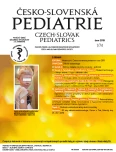Possibilities of antibiotic treatment of acute sinusitis
Authors:
I. Šlapák
Authors‘ workplace:
Klinika dětské ORL LF MU a FN Brno
Published in:
Čes-slov Pediat 2019; 74 (1): 41-42.
Category:
Review
Overview
Acute sinusitis (sinusitis) is most often a complication of acute inflammation of the upper respiratory tract and is reported to occur in 0.5–10% of all childhood cases.
The development and emergence of sinusitis occurs most often by closing the natural estuary of the paranasal cavity into the nasal cavities by swelling and edema of the mucosa. Classical local symptoms include mucosal secretion from the nose, one-sided or two-sided, headache and worsening of nasal passage. The overall symptoms include fever, coughing in the day and night, and unrest in the child. The most common sinusitis agents are Streptococcus pneumoniae, Moraxella catarrhalis and Haemophilus influenzae.
Locally, corticoid sprays and rinses of the nose with mineral or seawater are used locally for the treatment of sinusitis. Generally, antihistamines and anti-fever and pain medications can be used. In the event of failure of this underlying treatment, or when a complication is suspected, it is necessary to use antibiotics. A published study [2] of recent years compared the effect of cefprozil and amoxicillin in the treatment of acute sinusitis in fifty pediatric patients divided into two groups according to the administered drug. The study presented included children aged 6 months to 11 years in the 10-day amoxicillin group and in the 10-day cefprozil administration group, children from 5 months to 17 years of age. Amoxicillin was dosed with 40 mg/kg/day, cefprozil at 15 mg/kg/day. In the amoxicillin-treated group, treatment success was demonstrated in 82% of children, and in the cefprozil-treated group, treatment success was 94%, with 10 daily dosing. The study demonstrated that cefprozil had less recurrence of the disease and higher therapeutic success compared to amoxicillin. For both antibiotics, there were no such adverse effects that would have to be discontinued, respectively end. Cefprozil can therefore be considered a suitable antibiotic for the treatment of acute sinusitis.
Keywords:
antibiotics – childhood acute sinusitis – rhinoscopy – cefprozil
Sources
- Klačanský J, Jakubíková J. Detská otolaryngológia. Martin: Osveta, 1992.
- Simon MW. Cefprozil vs Amoxicillin in the treatment of childhood acute sinusitid. Int Pediatr 2000; 15 (2): 93–96.
- Šlapák I, a kol. Dětská otorinolaryngologie. Praha: Mladá fronta, 2013. ISBN 978-80-204-2900-1.
- Sičák M. Funkčná endoskopická chirurgie prinosových dutin. Martin: Kozák-Press, 2001. ISBN 80-900-482-4-2.
- Arora HS. Sinusitis in children. Pediatr Ann 2018 Oct 1; 47 (10): e396–-e401.
- Wu D, Wasserman J, Boruk M. Practice patterns of systemic corticosteroid use in complicated acute rhinosinusitis among rhinologists and pediatric otolaryngologist. Am J Rhinol Allergy 2018 Nov; 32 (6): 485–490. doi: 10.1177/1945892418797056. Epub 2018 Aug 30.
- Beswick DM, Messner AH, Hwang PH. Pediatric chronic rhinosinusitis management in rhinologists and pediatric otolaryngologists. Ann Otol Rhinol Laryngol 2017 Sep; 126 (9): 634–639.
- Persky MJ, Roof SA, Fang Y, et al. Cephalosporin use in penicillin-allergic patients: a survey of otolaryngologists and literature review. Laryngoscope 2015 Aug; 125 (8): 1822–1826.
Labels
Neonatology Paediatrics General practitioner for children and adolescentsArticle was published in
Czech-Slovak Pediatrics

2019 Issue 1
Most read in this issue
- Possibilities of antibiotic treatment of acute sinusitis
- The aetiology and treatment of neonatal diabetes
- The role of modern technologies in management of Type 1 diabetes in children
- Risk factors affecting the outcome of newborns undergoing therapeutic hypothermia for hypoxic-ischemic encephalopathy
